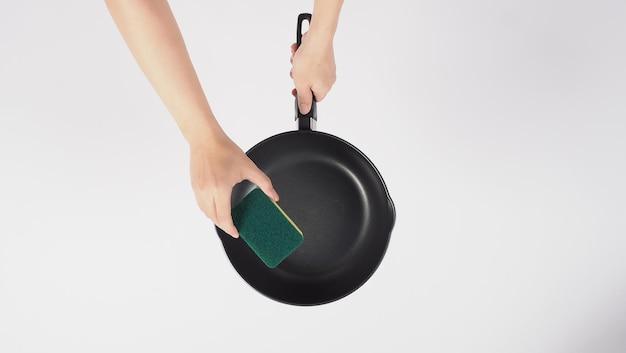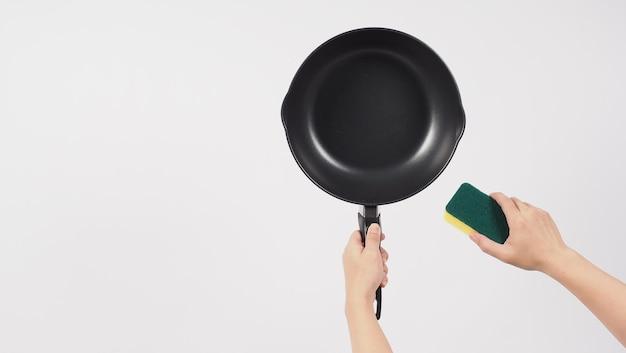If you love cooking, you know that having the right cookware can make all the difference in the results you achieve in the kitchen. When it comes to choosing cookware, two popular options are non stick and hard anodized. But what exactly do these terms mean, and how do they impact your cooking experience? In this blog post, we will delve into the world of cookware and explore the key differences between non stick and hard anodized options.
Non stick cookware is known for its easy food release properties, making it ideal for cooking delicate items like eggs and pancakes without worrying about sticking or burning. On the other hand, hard anodized cookware is renowned for its durability and excellent heat conductivity. But there’s more to it than meets the eye. We’ll explore the pros and cons of both types of cookware, address safety concerns, and help you decide which option is best suited for your cooking needs.
Let’s dive in and explore the world of non stick and hard anodized cookware, so you can make an informed decision about the pots and pans you bring into your kitchen.
What Is the Difference Between Non-Stick and Hard-Anodized
If you’ve ever found yourself standing in the cookware aisle, contemplating between non-stick and hard-anodized pans, you’re not alone. It’s a common dilemma that many home cooks face. To help you make an informed decision and prevent any culinary mishaps (or sticky situations), let’s dive into the differences between these two types of cookware.
Non-Stick: Slippery When Cooked!
Non-stick cookware is like that smooth-talking friend who can charm their way out of any sticky situation. It typically features a coating that prevents food from sticking to the surface, making cooking and cleaning a breeze. Whether it’s pancakes, eggs, or delicate fish fillets, you can expect these goodies to effortlessly slide right out of the pan.
But here’s the catch: not all non-stick coatings are created equal. In the past, the commonly used coating, known as Teflon, raised concerns due to the release of potentially harmful chemicals when overheated. However, fear not, as technological advancements have led to the development of PFOA-free coatings that are safer for regular use.
Non-stick pans are great for low-fat cooking, as they require less oil or butter to prevent sticking. They also heat up quickly and distribute heat evenly, ensuring your food cooks to perfection. However, keep in mind that non-stick coatings are prone to scratching, so avoid using metal utensils that could damage the surface.
Hard-Anodized: Tougher Than a Hangry Customer
If non-stick pans are the smooth talkers, then hard-anodized cookware is the strong, silent type. These pans undergo a special process called anodization, where their surface is hardened to create a durable and non-reactive layer. Don’t worry, no superheroes were involved in the making of these pans – just an electrochemical treatment.
Thanks to their sturdy construction, hard-anodized pans can handle the heat, literally. They are built to withstand high temperatures and won’t warp, scratch, or chip easily. You can use metal utensils and even put them in the oven without any worries.
While they may not have a slick non-stick coating, hard-anodized pans still offer relatively easy food release. They have a natural resistance to sticking, making them suitable for many cooking tasks. Plus, their dark exterior helps with heat absorption, resulting in thorough and uniform cooking.
So Which One Should You Choose
Well, it depends on your cooking style and needs. If you want the convenience of easy clean-up and the ability to cook with less oil, non-stick cookware is a fantastic option. Just be sure to choose PFOA-free coatings and handle them with care to prevent scratching.
On the other hand, if durability and versatility are your top priorities, hard-anodized pans should be your go-to. With their excellent heat retention and resistance to wear and tear, they are designed to be dependable companions in the kitchen.
Ultimately, investing in good-quality cookware is always a game-changer. Consider your cooking habits, preferences, and budget, and remember that having a mix of both non-stick and hard-anodized pans is never a bad idea! Happy cooking, fellow culinary enthusiasts!
Frequently Asked Questions About the Difference Between Non-Stick and Hard-Anodized Cookware
What are the pros and cons of hard-anodized cookware
Hard-anodized cookware has several advantages. It offers exceptional durability, resistance to scratches and dents, and even heat distribution. The non-porous surface prevents food from sticking, making it easier to clean. However, hard-anodized cookware can be prone to discoloration over time, especially when exposed to high heat.
Is anodized aluminum safe to smoke from
Anodized aluminum is primarily used in cookware and other consumer products. While no specific studies have been conducted on smoking through anodized aluminum, it is important to note that inhaling any form of burnt or heated material may pose health risks. It is best to use products specifically designed for smoking.
Is Cuisinart hard-anodized cookware PFOA free
Yes, Cuisinart hard-anodized cookware is PFOA-free. Perfluorooctanoic acid (PFOA) is a synthetic chemical sometimes used in the production of non-stick coatings. Cuisinart prioritizes the safety of their customers and ensures that their cookware is free from harmful substances.
Is hard-anodized cookware nonstick
While hard-anodized cookware is not inherently nonstick, it has excellent stick-resistant properties. The anodizing process creates a smooth, non-porous surface that reduces the chances of food sticking to the pan. Though additional non-stick coatings can be applied to enhance the nonstick performance.
How long do hard-anodized pans last
With proper care and maintenance, hard-anodized pans can last for many years. Their durability and resistance to scratches and corrosion contribute to an extended lifespan. However, it is important to avoid abrasive cleaning methods or using metal utensils, as these can shorten the lifespan of the pans.
Is anodized cookware safe for birds
Anodized cookware is generally considered safe, even for birds. The anodizing process creates a hard, non-reactive surface that does not leach harmful chemicals into food or the environment. However, it’s always a good idea to consult a veterinarian before introducing any new materials into your bird’s environment.
Is anodized non-stick healthy
Anodized non-stick cookware can be a healthy option if used and maintained properly. The non-stick surface allows for healthier cooking with less oil or fat, while the anodized finish ensures durability and resistance to scratching. It is important to avoid using metal utensils to prevent damaging the non-stick coating.
Which is better, cast iron or hard-anodized cookware
Cast iron and hard-anodized cookware have different advantages. Cast iron provides excellent heat retention and an unmatched ability to develop a natural seasoning over time. On the other hand, hard-anodized cookware is lightweight, easier to maintain, and typically offers a non-stick surface. The choice depends on personal preference and cooking style.
Is hard-anodized cookware good for cooking
Yes, hard-anodized cookware is excellent for cooking. Its even heat distribution helps in preparing dishes with precise cooking temperatures. The non-stick properties of hard-anodized cookware make it suitable for cooking a range of foods while minimizing the need for excessive oil or butter.
What is the difference between Teflon and anodized pans
The main difference between Teflon and anodized pans lies in their composition and manufacturing processes. Teflon pans have a non-stick coating made of a synthetic polymer called polytetrafluoroethylene (PTFE). Anodized pans, on the other hand, undergo an electrochemical process that hardens the surface of the aluminum, making it non-porous and durable.
Does anodized aluminum wear off
Unlike traditional coating materials, anodized aluminum does not wear off easily. The anodizing process transforms the surface of aluminum into a harder, non-porous layer that is more resistant to scratches and corrosion. However, it is still essential to handle anodized aluminum cookware with care to maintain its longevity.
Is hard-anodized cookware good
Yes, hard-anodized cookware is highly regarded for its durability and excellent heat distribution. The anodizing process makes the cookware resistant to scratches, corrosion, and warping. Additionally, its non-stick properties and ease of cleaning make it a convenient choice for both professional chefs and home cooks alike.
What are the healthiest pans to use
The healthiest pans to use are ones that are free from toxic substances and promote even cooking. Stainless steel, ceramic, and hard-anodized cookware are all excellent choices. These materials are durable, non-reactive, and can help you cook with minimal oil or fat, ensuring healthier meals.
What is the advantage of hard-anodized cookware
One of the main advantages of hard-anodized cookware is its exceptional durability. The anodizing process creates a surface that is harder than stainless steel, making it resistant to scratches, dents, and corrosion. Additionally, hard-anodized cookware offers even heat distribution and a non-stick surface, making it a versatile and convenient choice in the kitchen.
What is better, stainless steel or hard-anodized cookware
Choosing between stainless steel and hard-anodized cookware depends on your cooking preferences. Stainless steel is known for its timeless appeal and excellent heat conductivity. It is also relatively easy to clean. On the other hand, hard-anodized cookware offers superior durability and a non-stick surface, making it a great option for dishes that require even heat distribution and minimal sticking.
What does hard-anodized mean in cookware
Hard-anodized refers to a specific electrochemical process that strengthens the surface of aluminum cookware. The process involves immersing the aluminum in an electrolytic bath and passing an electric current through it. This creates a hard oxide layer that is resistant to scratches and corrosion, making the cookware more durable and long-lasting.
Is hard-anodized cookware dishwasher safe
Yes, most hard-anodized cookware is dishwasher safe. However, to maintain its longevity and non-stick properties, it is generally recommended to hand wash hard-anodized cookware using mild dish soap and non-abrasive cleaning tools. Always refer to the manufacturer’s instructions for specific care and maintenance guidelines.
Which one is better, hard-anodized or nonstick
The choice between hard-anodized and non-stick cookware depends on personal preference and cooking needs. Hard-anodized cookware offers exceptional durability, even heat distribution, and a non-stick surface without relying solely on coatings. Non-stick cookware, on the other hand, focuses primarily on the non-stick properties. Consider your cooking style and priorities when deciding which one is better for you.
Is granite coating better than Teflon
Granite coating and Teflon both offer non-stick properties, but there are some differences. Granite coating is typically infused with a blend of minerals and ceramic particles, providing a natural and durable non-stick surface. While Teflon is a brand name for a specific type of non-stick coating. The choice between the two often depends on personal preference and desired durability.
What is the difference between hard-anodized and titanium cookware
The main difference between hard-anodized and titanium cookware lies in the materials used and their characteristics. Hard-anodized cookware is made of aluminum that has been specially treated to create a durable, non-porous surface. Titanium cookware, on the other hand, is made of lightweight and corrosion-resistant titanium. Both types offer excellent heat distribution and durability, but titanium cookware is generally lighter.
Is hard-anodized cookware safe to use
Yes, hard-anodized cookware is safe to use. The anodizing process creates a hard, non-reactive surface that prevents aluminum from leaching into food. However, it is important to follow proper cooking and maintenance practices. Avoid using metal utensils or abrasive cleaners, which can damage the non-stick surface. Always consult the manufacturer’s instructions for specific usage guidelines.
Can you use metal utensils on hard-anodized cookware
While hard-anodized cookware is highly durable, it is generally recommended to avoid using metal utensils to preserve its non-stick properties. Metal utensils can scratch the non-stick coating, reducing its effectiveness over time. Instead, opt for wooden, silicone, or nylon utensils that are gentle on the surface of the cookware.

